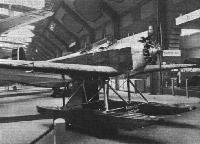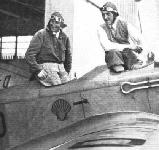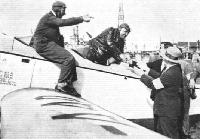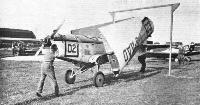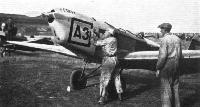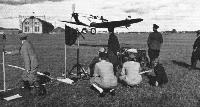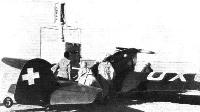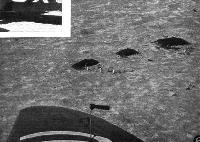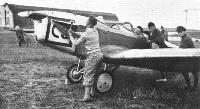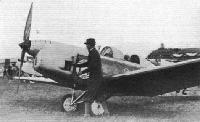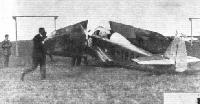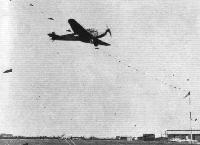
Описание
Страна : Германия
Год : 1927
Двухместный легкий учебно-тренировочный самолет
Варианты
- Daimler - L 20 - 1924 - Германия
- Klemm - L.25 - L.28 Swallow - 1927 - Германия
- British Klemm - L.25 Swallow - 1933 - Великобритания
Klemm. Легкие самолеты
Доктор технических наук Ганс Клемм сделал успешную карьеру конструктора легких самолетов. Вскоре после окончания Первой мировой войны он пришел на "Daimler", а в 1926 году основал в Бёблингене близ Штутгарта собственную фирму "Klemm Leichtflugzeugbau GmbH".
Первым серийным изделием новой фирмы стал Klemm L 25, выпускавшийся в течение нескольких лет (всего построено более 600 самолетов). В исходном варианте этот двухместный низкоплан оснащался двухцилиндровым мотором Mercedes-Benz мощностью 20 л. с., но на последующих вариантах, включая L 25 1а, стояли 40-сильные моторы Salmson AD-9. Известны следующие модели: гидросамолет WL 25 1a и трехместный L 25 1b с закрытой передней кабиной для двух человек.
Линию L 25 продолжили такие самолеты, как L 26a облегченный и усиленный; L 27 с увеличенной передней кабиной; акробатический L 28 с мотором Siemens Sh 14a мощностью 150 л.с.; а также L 30, похожий на L 25/L 26, но предназначенный для сборки непосредственно в аэроклубах.
<...>
Описание:
- Klemm. Легкие самолеты
- Flight, October 1928
Berlin Aero Show 1928 - Flight, June 1929
OLYMPIA AERO SHOW 1929 - Flight, April 1930
AIRCRAFT FOR THE PRIVATE OWNER - Flight, October 1931
AN INTERESTING LIGHT AIRCRAFT - Flight, January 1932
For a Quick takeoff
Фотографии
-
Aeroplane Monthly 1977-01 / N.Parnell - Veteran Klemm Swallow
Регистрационный номер: VH-UUR [4] -
Aeroplane Monthly 1977-01 / N.Parnell - Veteran Klemm Swallow
Регистрационный номер: VH-UUR [4] -
Aeroplane Monthly 1999-10 / S.McKay - Ben Cooper /Obituary/
Регистрационный номер: G-AAUP [5] Ben Cooper flying his Klemm L.25, G-AAUP Clementine, for the last time, on the evening of September 22, 1986. The aircraft has since been undergoing a leisurely restoration.
-
Flight 1929-07 / Flight
THE KLEMM-SALMSON LIGHT 'PLANE: This machine is exhibited on the stand of S. T. Lea.
-
Air Pictorial 1956-03 / Photos by request
Регистрационный номер: G-AAHW The earliest example of the G-AA' series still flying is G-AAHW, the 1929 two-seat Klemm L.25a-1 (c n. 1152) owned by G. R. Lush of Hastings. Engine is a Salmson AD9 radial.
-
Flight 1930-04 / Flight
The little Klemm monoplane with Salmson engine was much in evidence, and is here seen flying low, piloted by Flying Officer Alliott. Later in the day one of the "Moths" charged the Klemm, which was somewhat "bent."
-
Flight 1930-04 / Flight
NORWICH AIR DISPLAY: The Klemm (40-h.p. Salmson) light monoplane.
-
Flight 1930-05 / Flight
Mr. John Rogers gives a display of slow flying on the Salmson-engined Klemm monoplane.
-
Flight 1936-04 / Flight
Mr. A. J. Richardson, the 74-year-old enthusiast, put his hands up in surrender when a strange biplane "attacked" his Salmson Klemm as he flew it towards his ground at North Walsham, Norfolk; and the biplane's passenger was armed with a camera.
-
Flight 1929-06 / Flight
Mr. John Tranum astride the Klemm monoplane in flight.
-
Flight 1929-05 / Flight
AT THE BRISTOL CLUB MEETING: Sir Alan Cobham, carrying passengers in his D.H. "Giant Moth" ("Jaguar"), has a "Hun on his tail" in the form of the little Klemm monoplane.
Другие самолёты на фотографии: De Havilland Giant Moth / D.H.61 - Великобритания - 1927
-
Flight 1929-12 / Flight
The Sprat and the Whale: When the "Graf Zeppelin" visited Boblingen recently, the German Concessionnaires for Wakefield "Castrol" sent up a Klemm light 'plane bearing a Castrol advertisement, as shown in the accompanying photograph.
-
Flight 1929-07 / Flight
GETTING THEM DOWN AT WAALHAVEN: Various styles of landing over the tape are shown. 1. Bos on Klemm-Salmson.
-
Flight 1929-12 / Flight
The finish of the East-West Australian Race at Mayland Aerodrome. A Klemm, which is the Service machine of the Lang Tractor Co., is just coming in.
-
Aeroplane Monthly 1978-09 / News Spotlight from Strathallan
Регистрационный номер: G-AAUP [5] Bob Russell on final approach in his Klemm L.25-Ia G-AAUP Clementine, normally based at Kilkerran.
-
Air Enthusiast 1994-09 / S.Bohill-Smith - On the Wings of a Klemm
Регистрационный номер: G-AAUP [5] The only airworthy example of a Klemm L 25 in the UK is G-AAUP, Clementine. Built in 1929 and powered by a 9-cylinder 40hp (30kW) Salmson engine the 43ft (13m) wingspan shows the type’s gliding ancestry.
-
Air Pictorial 1977-08
Регистрационный номер: G-AAUP [5] Rare type at the Blackpool Air Pageant on 27 th May 1977 was Klemm L.25-1A G-AAUP "Clementine". It arrived by trailer and is seen being assembled
-
Flight 1930-07 / Flight
Регистрационный номер: G-AAZH FOREIGN COMPETITORS: The Breda and Klemm at the flying meeting.
Другие самолёты на фотографии: Breda Ba.15 - Италия - 1928
-
Air-Britain Archive 1980-01
Регистрационный номер: G-AAFU This Klemm L-25 G-AAFU with Salmson radial is believed to have been scrapped about 1939.
-
Flight 1929-07 / Flight
The Klemm-Salmson monoplane is exhibited on the stand of S. T. Lea, who holds the British rights for this machine.
-
Flight 1931-06 / Flight
THE LOW-LIMIT: Mr. Edwardes, Klemm (Salmson), waiting for the flag. He was first man away and led for many miles en route to Cramlington. Mr. Reynolds is the timekeeper while Capt. Dancy, on his right, looks as if he was satisfied with the work he and Mr. Rowarth had done in handicapping the entries (and rightly so too!).
-
Flight 1930-07 / Flight
SEEN AT HESTON: GERMAN MONOPLANE TAKING PART IN THE COMPETITION: 2, a Klemm with Salmson engine with Townend fitted Ring.
-
Flight 1934-03 / Flight
OVER HANWORTH: Mr. E. G. Hordern flying the Salmson-engined British Klemm "Swallow" in front of the club hangar at Hanworth.
-
Flight 1934-03 / Flight
Регистрационный номер: G-ACMK [2], EI-ADS [2] NEAR THE GROUND: Its excellent manoeuvrability enables the Klemm to be flown so that pictures may be obtained from the ground like this.
-
Aeroplane Monthly 1983-02 / L.Curtis - Flying for all
Регистрационный номер: G-ACMZ Though a British Klemm Swallow is seen here, the Civil Air Guard used more than 40 Pobjoy Cataract or Cirrus Minor-powered B.A. Swallows.
-
Flight 1929-04 / Flight
The Klemm Team at Lympne: (Left to Right) Maj. Stephens, Herr F. Kirsch, Mr. H. Barlow and Herr L. Hagemieir. Herr F. Kirsch flew 600 miles in the Klemm (Salmson) monoplane on Good Friday to attend the meeting. He started from Stuttgart, Germany
-
Flight 1934-03 / Flight
FOR EASY HANDLING: A good view which shows the lever for withdrawing the front wing joint pins and also the catch in the leading edge making wing folding a one-man job.
-
Flight 1928-10 / Flight
The Klemm L.25 W seaplane is a two-seater with 40 h.p. Salmson engine. This machine has taken off the water with three on board. The float undercarriage is interchangeable with the landplane unit.
-
Air-Britain Archive 1980-02
Регистрационный номер: G-AAUP [5] The Klemm L.25 G-AAUP still languished in the Dumfries garage in 8.62 when this photo was taken.
-
Flight 1930-05 / Flight
KLEMM TYPES: The nose of the new Siemens - Klemm belonging to Mr. R. Denman
-
Flight 1930-05 / Flight
KLEMM TYPES: The new Siemens - Klemm belonging to Mr. R. Denman
-
Flight 1930-07 / Flight
SEEN AT HESTON: GERMAN MONOPLANE TAKING PART IN THE COMPETITION: 3, An "unfaked" Klemm with Siemens engine.
-
Flight 1934-05 / Flight
Регистрационный номер: D-2495 [L.28] A FAIR WINNER: Miss Liesel Bach, of Germany, who won the International Feminine Cup in her Klemm monoplane.
-
Flight 1932-01 / Flight
Регистрационный номер: G-ABTE [2] The Klemm-Pobjoy in a tight turn around our photographer. The neat way in which the engine fits on the nose of the fuselage is well shown here.
-
Flight 1932-07 / Flight
"QUICK OFF THE MARK": Mr. A. B. Gibbons using his Pobjoy engine to pull his "Klemm" off the ground in 49 ft. at Brooklands last Sunday.
-
Flight 1934-03 / Flight
A CLEAN FRONT: Large wing area and low wing loading give this Pobjoy-engined British Klemm "Swallow" a spectacularly low landing speed.
-
Flight 1934-03 / Flight
A view showing the newly-designed, sturdy undercarriage.
-
Flight 1932-01 / Flight
Регистрационный номер: G-ABTE [2] The exceptional take-off of the Klemm-Pobjoy is clearly shown in this photograph. The wheels are already off the ground although there are still several yards to the end of the tarmac.
-
Aeroplane Monthly 1990-08 / Skywriters
Регистрационный номер: G-ACRD The British Klemm L.25C 1A Swallow flown by Jack Meadows at pre-war Ipswich. Registered in May 1934 to the Rt Hon F. E. Guest, 'RD passed to the Weston Aero Club in December 1938 and was presumably seconded to Ipswich.
-
Air Pictorial 1958-01
Регистрационный номер: EI-ADS [2], G-ACMK [2] The prototype Hanworth-built B.K. Swallow, EI-ADS (c/n. 1, ex G-ACMK), still flies at Weston, near Dublin. It is twenty-four years old and became Irish in June 1947. Now Pobjoy-powered, it first flew with a Salmson radial.
-
Flight 1932-06 / Flight
Регистрационный номер: D-2100 Count Arco-Zinneberg and Capt. Bistritschan starting on the Austrian Rund-Flug in the former's Klemm (Pobjoy).
-
Flight 1933-09 / Flight
PRACTICAL RESEARCH: Sir John Carden, who has been doing a lot of useful experimental work in connection with silencers for aircraft engines, with his specially silenced Klemm, which won the prize for the "quietest engine" at the Hook Aerial Garden Party on September 6
-
Flight 1934-07 / Flight
Types of Machine in the King's Cup Race (3) British Klemm "Swallow," Pobjoy "Cataract" 80 h.p. engine.
-
Flight 1934-11 / Flight
BRITISH KLEMM "SWALLOW" 80 h.p. Pobjoy "Cataract"
-
Flight 1930-04 / Flight
Регистрационный номер: D-8 -
Flight 1930-07 / Flight
THE KLEMM: Mr.Rogers standing before a Cirrus-Klemm.
-
Flight 1930-05 / Flight
KLEMM TYPES: A Klemm with a Cirrus III.
-
Flight 1930-09 / Flight
Регистрационный номер: G-AAWW [2] Mr. Runciman (second of the Grosvenor Cup)
-
Flight 1938-12 / Flight
Регистрационный номер: G-AAWW [2] A striking photograph that conveys the tenseness (usually felt by everybody but the parachutist himself) just before the jump. It shows the author about to make his first professional jump, and from a low altitude, at Coventry in 1932.
-
Flight 1931-08 / Flight
THE WINNER: The Klemm L.26 Va (Argus As 8) which Lieutenant Dinort flew to victory.
-
Flight 1932-06 / Flight
Регистрационный номер: D-1916 MACHINES AT THE INTERNATIONAL AVIATION MEETING, ST. GERMAIN-EN-LAYE: Miss Liesel Bach (Germany) and her Klemm (100-h.p. inverted Argus).
-
Flight 1931-08 / Flight
THE WINNER: Oskar Dinort and his passenger Freiherr von Houwald.
-
Flight 1932-09 / Flight
Herr Wegenast, President of the Dusseldorf Aero Club, talking to Mr. Nigel Norman after landing at Heston. His pilot is Herr Niehues.
-
Flight 1931-08 / Flight
Регистрационный номер: TS-AAD [2] THIRD MAN HOME AGAIN: Adolph Kneip greeted on his arrival at Tempelhof upon his getting third place in the "Deutschlandflug."
-
Flight 1932-04 / Flight
The German girl pilot addressing an interested group inside the hangar. Fraulein Beinhorn is now in Sydney, and we understand that she proposes to ship her machine to San Francisco, continuing her journey by air from that point to Pernambuco via Los Angeles, San Diego, Tucson, El Paso, Chihuahua, Mexico City, Guatemala, Nicaragua, Panama, Buenaventura, St. Lorenzo, Quito, Cuenta, Lima, Iquique, Valparaiso, Santiago, Mendoza, Rosario, Buenos Aires, Montevideo, Rio Grande do Sul, Porto Aleere, S. Paulo. Rio de Janeiro, San Salvador, Pernambuco. From that point she will return to Germany by boat.
-
Flight 1931-08 / Flight
Регистрационный номер: TS-AAD [2] THE FOLDING AND "DOOR-WHEELING" TEST: Kneip's machine going through the "gate."
-
Flight 1931-08 / Flight
FIRST IN THE TECHNICAL TESTS: Reinhold Poss (Klemm-Argus) secured the highest number of points in the technical tests.
-
Flight 1931-08 / Flight
IN THE LANDING TEST: This year competitors did not have to land over an obstacle.
-
Flight 1932-04 / Flight
The picture - for which we are indebted to Shell Mex & B.P., Ltd. - come from Sourabaya, and show Elli Beinhorn's Klemm L.26 (110-h.p. Angus) landing there
-
Flight 1937-12 / Flight
SOME out-of-the-ordinary snapshots taken by a Swiss private owner, Dr. Werner Fusbahn, during a recent tour from Basle to Lake Chad in Central Africa, by way of the Sahara Desert. His machine was a Klemm Kl.25.
(5) Ubiquitous "Mr. Shell" has supplies in the most unlikely places. -
Flight 1937-12 / Flight
SOME out-of-the-ordinary snapshots taken by a Swiss private owner, Dr. Werner Fusbahn, during a recent tour from Basle to Lake Chad in Central Africa, by way of the Sahara Desert. His machine was a Klemm Kl.25.
(7) Picturesque lookers-on at refuelling operations. -
Flight 1937-12 / Flight
SOME out-of-the-ordinary snapshots taken by a Swiss private owner, Dr. Werner Fusbahn, during a recent tour from Basle to Lake Chad in Central Africa, by way of the Sahara Desert. His machine was a Klemm Kl.25.
(4) Supplies en route from a party of friends travelling by car. -
Flight 1937-12 / Flight
SOME out-of-the-ordinary snapshots taken by a Swiss private owner, Dr. Werner Fusbahn, during a recent tour from Basle to Lake Chad in Central Africa, by way of the Sahara Desert. His machine was a Klemm Kl.25.
(3) Picketing for the night with a simple anchor - a sackful of sand -
Flight 1937-12 / Flight
SOME out-of-the-ordinary snapshots taken by a Swiss private owner, Dr. Werner Fusbahn, during a recent tour from Basle to Lake Chad in Central Africa, by way of the Sahara Desert. His machine was a Klemm Kl.25.
(2) His bed the hard ground - a desert guard for the Klemm. -
Flight 1937-12 / Flight
SOME out-of-the-ordinary snapshots taken by a Swiss private owner, Dr. Werner Fusbahn, during a recent tour from Basle to Lake Chad in Central Africa, by way of the Sahara Desert. His machine was a Klemm Kl.25.
(6) Problem picture: The strange black mounds are the tents of wandering Beduins.
-
Flight 1931-10 / Flight
IN HER NATIVE HOME: The Klemm Two-seater taken at Boblingen where Herr Klemm has his factory. The neat engine cowling of this model is made possible by the small overall dimensions of the Hirth motor, while it being inverted gives the pilot an excellent view. It has 4 cylinders and gives 80 h.p.
-
Jane's All the World Aircraft 1938 / 03 - All the world's aeroplanes
The Klemm L.25 Two-seat Light Monoplane (70/80 h.p. Hirth H.M.60R engine).
-
Flight 1931-08 / Flight
ENGINE-STARTING TEST: Propeller-swinging was not permitted. Wolf Hirth's Hirth engine being started.
-
Flight 1931-08 / Flight
SECOND PRIZE: Wolf Hirth secured second place on the Klemm fitted with the engine designed by his brother Hellmuth Hirth, who is seen standing on the left.
-
Flight 1931-11 / Flight
INSTALLED IN A KLEMM MONOPLANE: The Hirth engine makes a very fine power plant for this machine, and is very smooth and quiet in running. Note the accessibility when the one-piece cowl is opened.
-
Flight 1931-08 / Flight
Some of the Competitors at Staaken Aerodrome before the Start.
-
Flight 1935-06 / Flight
Регистрационный номер: D-EMYV, D-EPAT, D-EPEM, D-EPET, D-ERIL A LOW-WING CONVENTION. This striking photograph, taken at Tempelhof, shows some of the 154 machines which took part in the recent Deutschlandflug (Circuit of Germany). In the foreground are a number of Klemms, a squadron of which, as reported last week, carried off the principal award.
-
Flight 1933-07 / Flight
AUS DEUTSCHLAND: One of the five German machines landing at Lympne. Each machine brought two visitors.
-
Aeroplane Monthly 1985-04 / J.Crookshank - Facelift for the Deutsches Museum
Регистрационный номер: D-EMDU The museum's Junkers-F 13, with the Klemm L.25 suspended behind it and the Messerschmitt M 17 at right.
Другие самолёты на фотографии: Junkers F 13 - Германия - 1919Messerschmitt S15 / S16 / M.17 - Германия - 1923
-
Jane's All the World Aircraft 1938 / 03 - All the world's aeroplanes
Регистрационный номер: D-EKJO The Klemm L.25 Two-seat Light Seaplane (70/80 h.p. Hirth H.M.60R engine).
-
Aeroplane Monthly 1996-04 / Personal album. Civil
Регистрационный номер: HA-OBC Klemm KI.25 HA-OBC at Sopron sporting airfield on the Austrian border. The gliders appear to be Rubik R.07b Vocsoks of 1940 vintage.
Другие самолёты на фотографии: Rubik R-07 Vocsok - Венгрия - 1937
-
Aeroplane Monthly 1977-01 / N.Parnell - Veteran Klemm Swallow
Регистрационный номер: VH-UUR [4] -
Aeroplane Monthly 1977-01 / N.Parnell - Veteran Klemm Swallow
Регистрационный номер: VH-UUR [4] -
Aeroplane Monthly 1974-12 / News Spotlight
Регистрационный номер: OH-ILI [2] The Klemm 25 OH-ILI was built in 1928 and is now the oldest aircraft flying in Finland.
-
Air Pictorial 1977-11 / M.Hooks - Finland's Air Show
Регистрационный номер: OH-ILI [2] Oldest powered aircraft at the Show was Klemm Kl 25D OH-ILI "Adolf Aarno".
-
Aeroplane Monthly 1999-06 / B.Schlussler - Melitta Schiller. Germany's other wartime woman test pilot /Test pilot biography/
Регистрационный номер: D-EHIN Melitta and her navigator Hildegard Alt won the 1938 reliability competition for amateur women pilots in the Klemm KI 25 D-EHIN.
-
Air-Britain Archive 1986-01
Регистрационный номер: G-ABOP Portsmouth Municipal Aerodrome at home to an air display during 1932. Right of the apron with Fury G-ABSE is the PSIoW Avn Wessex G-ABVB (CofA 5.32) while the row below that includes Widgeon G-AADE (w/o 9.32). Also identifiable are Sports Avian G-AAWI, Moths G-AAIM, G-AAJJ, Arrow G-ABOB and Klemm L.27a G-ABOP; several rows of Furies lead to the nearest row with two Harts (?), Vickers Virginia, Imperial Airways Argosy G-AACI, Desoutter G-AAZI and Fokker F.VIIa G-EBTS all visible.
Другие самолёты на фотографии: Armstrong Whitworth Argosy - Великобритания - 1926Avro Avian / Type 594/616 - Великобритания - 1926De Havilland Gipsy Moth / Moth X - Великобритания - 1928Fokker F.VII / C-2 / F.XIV - Нидерланды - 1924Hawker Fury - Великобритания - 1931Hawker Hart - Великобритания - 1928Koolhoven FK-41 - Нидерланды - 1928Spartan Arrow - Великобритания - 1930Vickers Virginia - Великобритания - 1922Westland Wessex / Westland IV - Великобритания - 1929Westland Widgeon - Великобритания - 1924
-
Flight 1935-04 / Flight
BERLIN LOOKS SKYWARD. The annual "People's Flying Day" was celebrated at Tempelhof Airport last Sunday, and this time the open possession of an air force added to the spectacular nature of the event, which was combined with "Air Force Day," the anniversary of Richthofen's death. The formation seen in this photograph is a very non-aggressive one of Klemm monoplanes.
-
Flight 1930-08 / Flight
THE COFFEE MILL: Starting the Argus engine of a Klemm.
-
Flight 1930-07 / Flight
STYLE IN COUPE TOPS: One of the Klemms. The cabin roof of the Klemm telescopes, the panels being celluloid covered.
-
Flight 1930-07 / Flight
SOME "RUNDFLUG NOSES": 3, a Klemm with inverted Argus engine. The cockpit roof telescopes.
-
Flight 1930-08 / Flight
VARIOUS STYLES OF WING FOLDING: These photographs from the International Touring Competition indicate how aircraft designers of various nationalities provide for reducing space required for garaging machines. 1. a Klemm has its wings dismantled and stacked on the side.
-
Flight 1930-08 / Flight
Poss, on a Klemm-Argus, clearing the obstacle.
-
Flight 1930-07 / Flight
A SWISS COMPETITOR: This Klemm monoplane with inverted Argus engine has been entered and is being piloted by Herr Charles Kolp. Note that it has a coupe roof built over cockpits.
-
Air Pictorial 1956-11 / Air Pictorial's photo-review
Регистрационный номер: SL-AAB SAARLAND-REGISTERED Klemm VL.25a (SL-AAB) has beautiful finish, redesigned and enclosed cockpits and ex-L-4 Cub flat-four engine.
-
Air-Britain Archive 1987-01
Регистрационный номер: G-ASCO Peter Amos acquired four photos of this accident at a collectors' fair and sent them in to us in the hope of obtaining some information about the incident. The aircraft is British Klemm L.25c-Ia G-ACSO which was actually written-off in a hangar collapse in 1952. The prints, of which we reproduce one here, have a pre-war appearance but the only real clue may be the note on one of them identifying "H.H.Syke's Aeroplane" which presumably refers to the owner. Anyone who can suggest the date and location of the accident, which seems to be an overshoot into a fence and hedge, is welcome to write to the Editor. This is one case in which we do not know the answer in advance!
-
Aeroplane Monthly 1988-12 / P.Masefield - Wren
Wren's first contribution to C. G. Grey's The Aeroplane was published in the issue for June 22, 1933. It was titled: Identification made easy - a caricaturist’s memories of the prominent characteristics of some popular aeroplanes.
Другие самолёты на фотографии: Airspeed Ferry / AS.4 - Великобритания - 1932Armstrong Whitworth Atlas / Ajax - Великобритания - 1925Avro Avro 504 - Великобритания - 1913Blackburn Bluebird / L.1 - Великобритания - 1924Blackburn Iris / R.B.1 - Великобритания - 1926Bristol Bulldog - Великобритания - 1927Cierva/Avro C.30A / Rota - Великобритания - 1932Comper Swift / CLA.7 - Великобритания - 1930De Havilland Gipsy Moth / Moth X - Великобритания - 1928De Havilland Puss Moth / D.H.80 - Великобритания - 1929Fairey Fairey IIIF - Великобритания - 1926Handley Page H.P.42 / H.P.45 - Великобритания - 1930Handley Page Hyderabad/H.P.24 / Hinaidi/H.P.33 / Clive/H.P.35 - Великобритания - 1923Hawker Fury - Великобритания - 1931Supermarine Southampton / Solent - Великобритания - 1925Vickers Jockey / Type 151 - Великобритания - 1930Vickers Virginia - Великобритания - 1922Westland Wapiti - Великобритания - 1927Westland Widgeon - Великобритания - 1924
-
Flight 1929-07 / Flight
The shock absorbers are housed in the wing of the Klemm-Salmson.
- Фотографии



























